ILM visual effects supervisors Mohen Leo and Scott Pritchard, along with members of their talented crew, discuss the process behind building the TIE Avenger as it journeyed from concept to screen.
By Jay Stobie
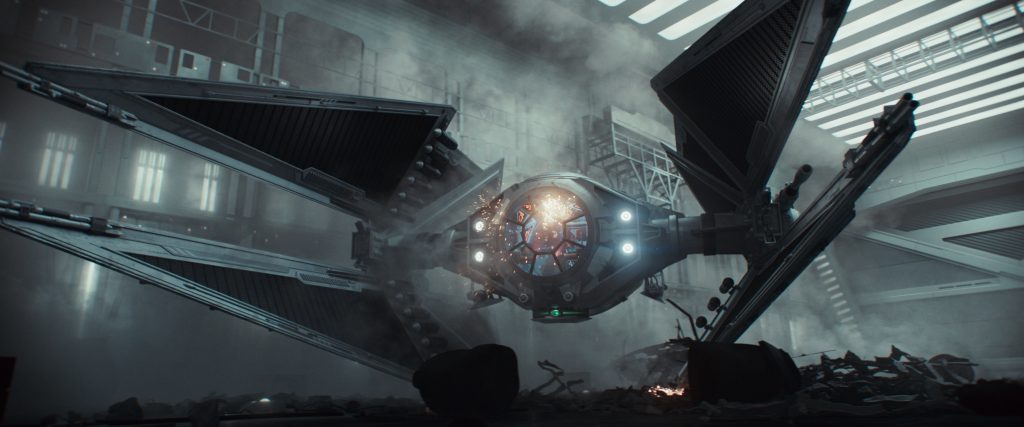
For many Star Wars enthusiasts, the word “avenger” conjures up images of Captain Needa’s Imperial Star Destroyer Avenger, the TIE Avenger starfighter featured in Lucasfilm Games’s Star Wars: TIE Fighter (1994) video game, or even Marvel’s prestigious superhero collective. The second season of Andor (2022-2025) has now pushed its own TIE Avenger to the forefront of that list, as the epic series chronicled Cassian Andor’s (Diego Luna) theft of the prototype craft from a Sienar Fleet Systems test facility. Outfitted with advanced armaments and a hyperdrive, the TIE Avenger transported Cassian to Yavin 4 before playing a key role in rescuing Bix Caleen (Adria Arjona) and Wilmon Paak (Muhannad Ben Amor) from Imperial forces on Mina-Rau.
Industrial Light & Magic’s Mohen Leo, whose resume boasts projects like Ant-Man (2015), The Martian (2015), and Rogue One: A Star Wars Story (2016), served as Andor’s production visual effects supervisor for both seasons of the series, while ILM visual effects supervisor Scott Pritchard (Star Wars: The Force Awakens [2015], Avengers: Infinity War [2018], Avengers: Endgame [2019]) oversaw the creative output of the work across ILM’s global studios in London, Vancouver, and Mumbai. Leo and Pritchard gathered alongside CG supervisor Laurent Hugueniot, modeler Owen Rachel, texture artist Emma Ellul, look development artist Renato Suetake, animation supervisor Mathieu Vig, and compositing supervisor Claudio Bassi to chart the TIE Avenger’s course from conceptualization to the completed sequences seen in season two.
Constructing the Concept
The TIE Avenger prototype is first unveiled at the beginning of season two, resting in its Sienar hangar bay before being commandeered by Cassian and embarking on a dramatic escape. “The idea for the opening sequence began with [showrunner] Tony Gilroy wanting to start season two off with a big, classic Star Wars action sequence,” Mohen Leo tells ILM.com. “That initially came out of an outline that Tony gave us in 2022. Early on, a big story point became that Cassian doesn’t know how to fly it, so the Avenger had to have completely unfamiliar controls, and the interior had to look different from any TIE fighter or ship that you’ve ever seen before.”
When it came to the Avenger’s look and layout, Leo worked closely with production designer Luke Hull. “Luke explored various prototype airplanes, and then we played around with the idea of what the ship needed to do in terms of the chase sequence. We wanted something that wasn’t just a dogfight. If he immediately jumps in and it’s just a chase, it’d be difficult to do something original with that,” adds Leo. “Luke had already decided to build a full-sized practical TIE Avenger. As far as its physical construction, the wings were inspired a bit by the TIE interceptor.” While Andor’s Avenger shares a name with the craft from the TIE Fighter game, it maintains its own design lineage. “I don’t think the previous ship was a strong influence,” Leo begins. “When we were designing our Avenger, how the ship functioned became something Luke and I reverse-engineered based on what we wanted the ship to do. That dictated the look.
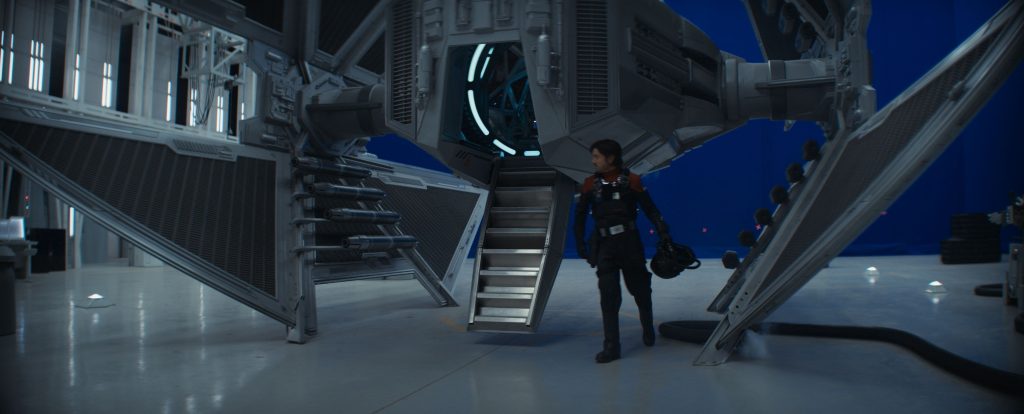

“I put together a pitch deck for the Avenger before we got into previs when the directors weren’t even on yet,” Leo continues. “I wanted to make sure that the ship and the weaponry, in particular, were based on real weapons and felt both dangerous and aggressive. The team based the TIE’s fold-out Gatling-like cannons on the United States military’s M61 Vulcan rotary cannon. Hull wanted the Sienar base itself to feel like a Skunk Works test facility or NASA’s Jet Propulsion Laboratory.
“It was a back-and-forth between previs and Luke Hull and the art department in terms of the ship’s design,” Leo notes. “We’d say, ‘We need guns that fold out,’ and then Luke would go, ‘Let me see where we can fit those in.’ It was almost as much driven by the necessity of the functionality as it was by the aesthetics.” Once the additional armaments, including external launchers and a powerful cannon below the cockpit, were set, the team pitched the action sequence to Tony Gilroy. “We blocked the whole sequence with a temp model, and Tony generally really liked it.”
Assembling the Avenger
“As the studio-side visual effects supervisor, I was involved in pre-production through to the end,” Leo shares. “I also guided the previs development with The Third Floor’s Jennifer Kitching and collaborated with Luke Hull on how we would make the practical build service what we needed to do in the visual effects sequence.” The creative dialogue between the ILM visual effects team and the production designer was vital in ensuring that the computer graphics (CG) starfighter built by ILM would be identical to the full-sized practical ship that was constructed to be used on the Sienar hangar, Yavin 4, and Mina-Rau sets.
“Because we had a practical version of the Avenger during the shoot, we were able to scan that and provide lots of references,” Leo details. As such, the full-scale Avenger proved beneficial for Owen Rachel, the ILM modeler responsible for building the CG Avenger. “My job was to take [the practical model] and replicate it as a digital version. There wasn’t much design work that we had to do other than replace some structural bits, like the Gatling guns as they come down,” Rachel outlines. “We did have to create the laser cannon that comes out from underneath the cockpit. It’s an intricate design because it’s both delicate and powerful at the same time. It felt a bit like the inside of a watch,” recalls CG supervisor Laurent Hugueniot, who was in charge of the team’s 3D output.
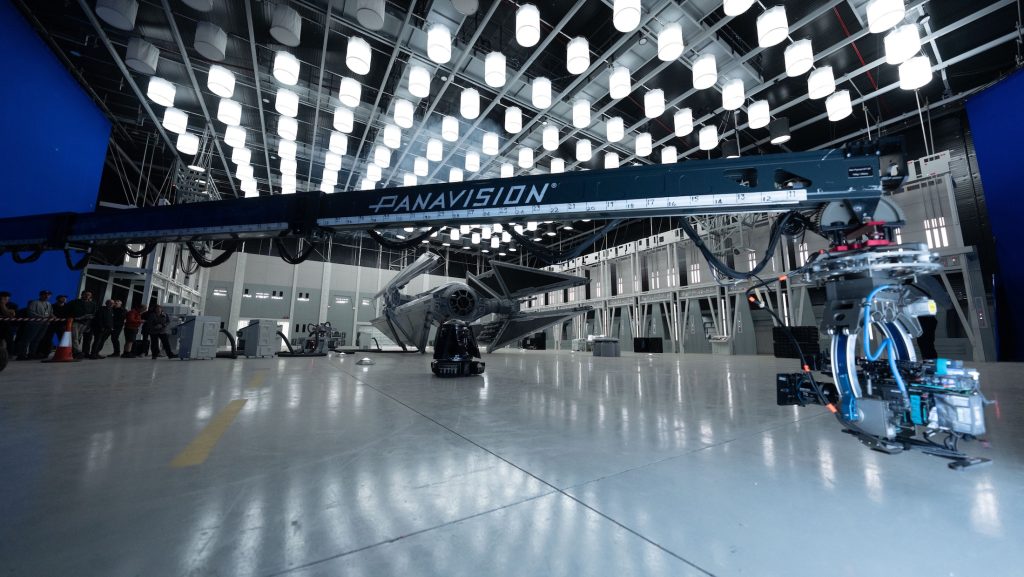
Texture artist Emma Ellul tackled the job of texturing the TIE Avenger. “We had great reference images, which was super helpful. I tried to focus on real-life objects, too, such as stealth planes. They’re quite smooth and angular, and I’d see how specularity affects the metal. Not every sheet of metal is made the same, so it has a slightly different bend or warping to it. I incorporated that, especially on the paneling on the outside of the wings,” Ellul relays. “There were a lot of nooks and crannies to look at and a lot of small decals everywhere, which I had to match one-to-one with the practical model. It was an awesome asset to texture. Who doesn’t want to texture a TIE fighter? And then I had to destroy it and chuck laser blasts all over it [laughs].”
Look development on the Avenger was handled by Renato Suetake, who asserts, “As a look dev artist, I get the model and textures so I can put them together and make the shaders. I make sure the shaders and materials react precisely like the reference we have in any situation or lighting condition. Certain shots jumped between the prop filmed on set and the CG version, so the digital Avenger had to be identical. At the same time, because the prop wasn’t made of metal, we still had to make it believable as an actual spaceship that flies.” From the Avenger’s weapons to the hangar explosions to the collapsing ice arch, Leo also credits the effects artists who contributed to the sequence, revealing, “In general, all of those things are just massive, complex simulation work.”
Pairing Computer Graphics and Practical Effects
As Andor’s ILM visual effects supervisor, Scott Pritchard helmed his team at ILM’s London studio, while coordinating the work at ILM’s studios in Vancouver and Mumbai. When it came to the Avenger’s breakout from the Sienar hangar, Pritchard observes that the production sought to use the “best tool for the job,” often pairing ILM’s CG expertise alongside special effects supervisor Luke Murphy’s practical effects. Highlighting a shot where an Imperial range trooper takes aim at the Avenger, Pritchard beams, “There’s a huge staged explosion along the back wall that was done by hanging a line of charges. They explode in sequence, so they explode outwards from the center. That in itself is impressive because it gives us some great visual reference to go on and actual practical elements to incorporate into the final comp.
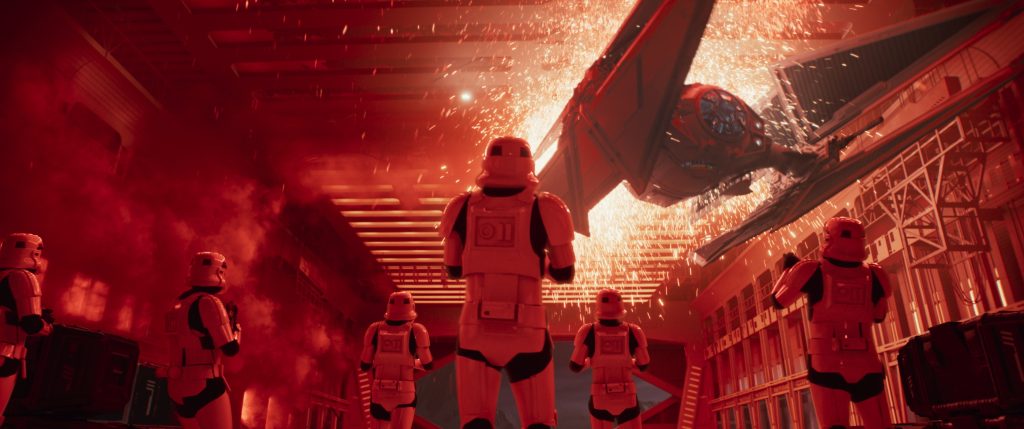
“There’s a significant amount of work involved in painting out the actual charges and all the little fragments that get blown off properly, as well. It gives you such a great base to work off when you’re putting together a shot like that,” continues Pritchard, who then shifts focus to the Avenger’s weapons blasting through the hangar. “A lot of these explosions are practical, but we’ve enhanced them by adding sparks and additional explosions in CG. Making all this work seamlessly is a great testament to the comp and effects team.”
Compositing supervisor Claudio Bassi concurs, believing that the practical effects supplied ILM with valuable reference for lighting purposes. Bassi also states that, despite the presence of the practical Avenger, the TIE’s wings during Niya’s (Rachelle Diedericks) inspection are actually CG. “The hangar set didn’t have a roof, so we often replaced the wings as it was easier to integrate the CG roof.” Although the hangar set was extremely large, Pritchard highlights the fact that ILM had to extend the hangar to an even greater width, and the entirety of the front section that opens toward the snowy exterior is also CG.
Maintaining a Match
Of course, having both a practical and digital Avenger presented its own challenges when it came to assuring that the details matched, particularly regarding how much damage the CG version sustained at Sienar in comparison to the practical model that was filmed on the Yavin 4 set. “Working with the art department, we knew that the Avenger had gone through the dogfight at Sienar base and should have scorch marks where lasers had hit it,” Leo remembers. “We counted the number of rockets it fired in the first sequence because there’s no way for him to restock in space. We took four specific missiles off the practical build, which we then reversed in digital effects to choose the four that he fires in the opening sequence.”
Hugueniot emphasizes that the same held true for the havoc wrought upon the Sienar hangar itself, commenting, “Not all shots are worked on one after another in story order. There’s a big job of keeping track of what’s going on in every shot. All the scorch marks on the walls, everything that’s been knocked down from the ceiling, and which lights are working in each shot. That was quite a job [laughs].” Bassi agrees, divulging, “We kept track of the marks where the Avenger scratched the floor and which lights broke, and we had a system to recognize them in shot order.”
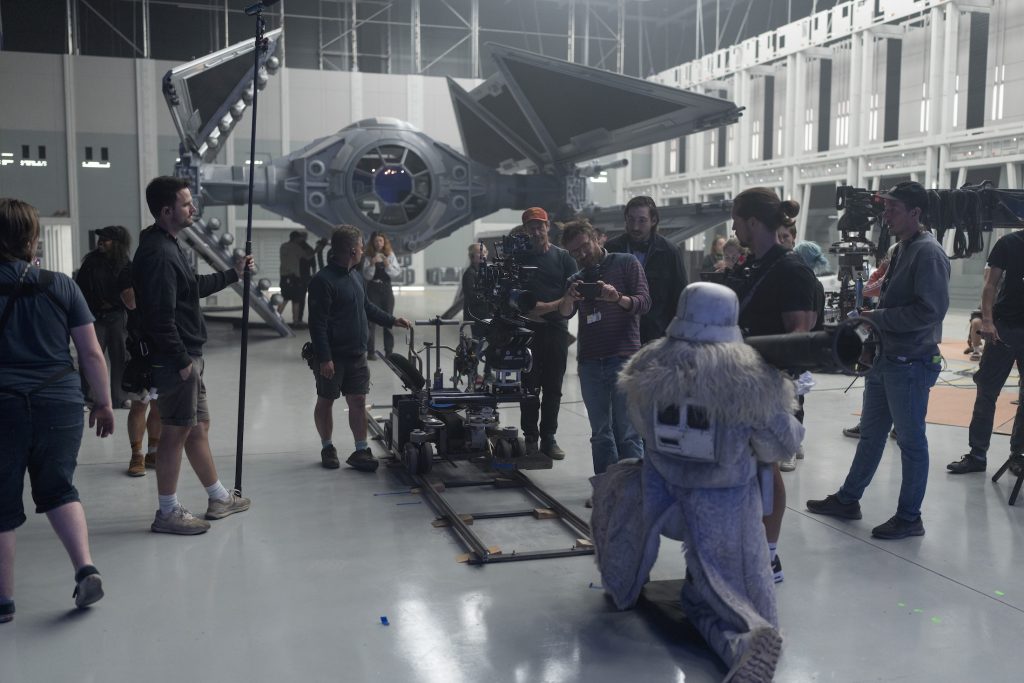
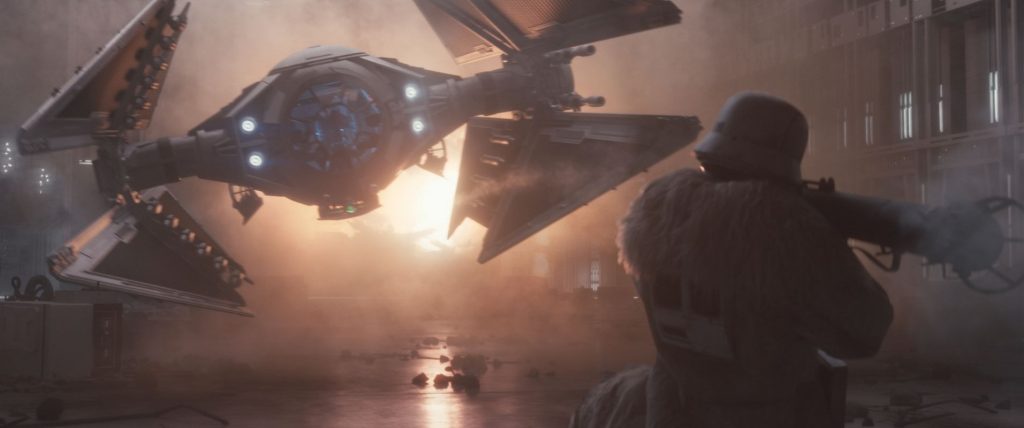
That level of realism was reflected in animation supervisor Mathieu Vig’s mission to make the Avenger look “heavy and dangerous, and as if it’s made of metal, not just pixels.” Having the Avenger scrape along the deck helped achieve this. “We’re used to seeing them [TIE fighters] flying very gracefully,” Vig explains. “Usually, we don’t animate them bumping around, so setting the weight is harder than you might think. In a hangar setting, there are so many physical elements to consider, such as the actor in the cockpit doing specific movements that we have to take into account. All of this is a carefully interlocking puzzle.”
Diving Into the Details
While analyzing the projectiles under the practical Avenger’s wings to model them for its digital counterpart, Owen Rachel recognized an intriguing connection. “When we were trying to work out how the missiles fire, we realized the design on the set was similar to those seen in Star Wars: A New Hope [1977], as they go into the exhaust port on the Death Star,” conveys Rachel. As it turns out, the design was a one-to-one match, so Rachel subsequently modeled the Avenger’s projectiles after the proton torpedoes that Luke Skywalker (Mark Hamill) fired at the first Death Star. Effort was also invested in preventing the Avenger’s Gatling-style spray of laser fire from appearing as though it simply hovered in mid-air. “We gave them a bit of an offset and some randomness in both their position in the stream and in their x- and y-axis, so we could get more chaos into that stream,” Pritchard elaborates.
Even the red light that flashes along with the hangar’s klaxon alarm was not nearly as simple as one might assume. ILM had to maintain a perfect rhythm between the flashing lights and klaxon, occasionally analyzing where the visual effects team needed to extend or shift the red light so it all remained in sync. “Compositing is basically the last step in the visual effects pipeline that ensures that all elements are integrated and the CG matches with the plate that has been shot on set,” describes Bassi, who worked alongside Pritchard to successfully pitch the idea that the overall light energy of the hangar would get progressively darker and moodier as the Avenger knocked lights off the ceiling.
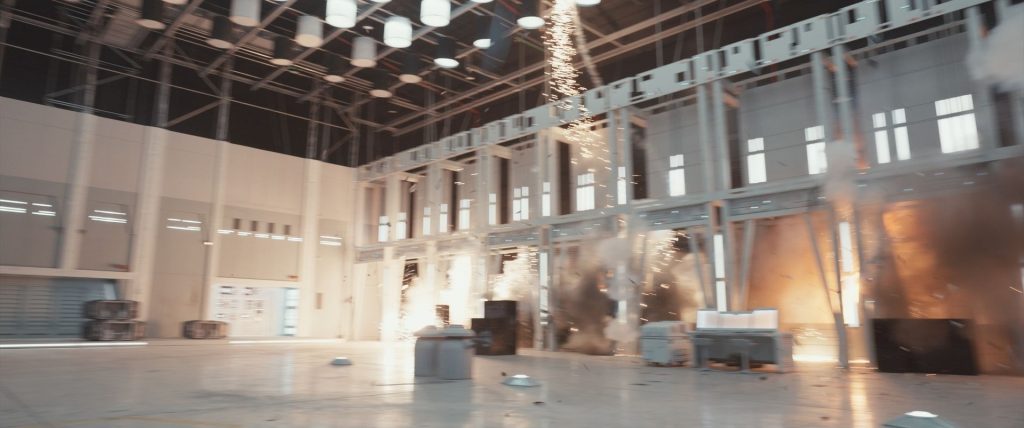
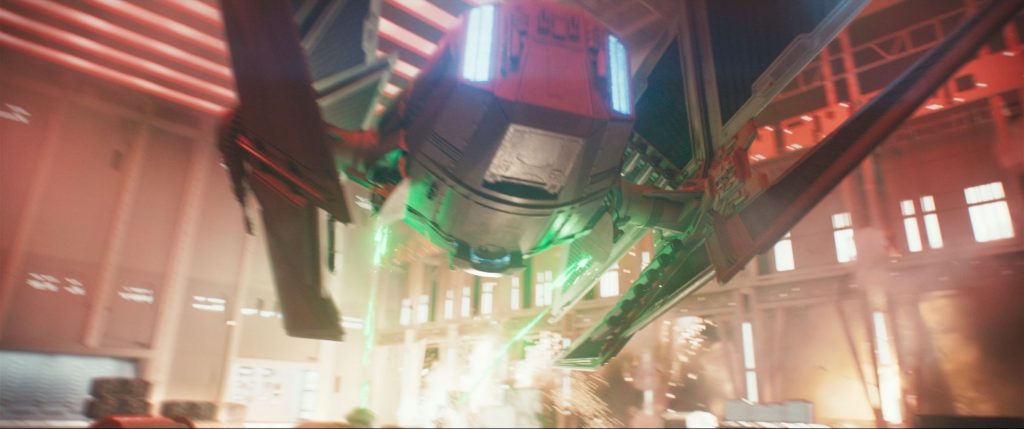
Matching the interior views of the practical and CG Avenger cockpits proved to be another challenge. “ILM’s Vancouver studio did a hologram of Cassian in season one that was absolutely fantastic and so lifelike. We reused that for Cassian’s head,” Hugueniot recounts. Filming Diego Luna in the practical cockpit occurred toward the end of the shoot, as Leo clarifies, “That was the very last thing we shot on the whole project—Diego in a motion base cockpit that we could move around and rattle. I think Diego had a really good time shooting those bits [laughs].”
In Awe of the Avenger
With season two now streaming on Disney+, the visual effects team has been able to view the completed episodes and finally share their work on the TIE Avenger prototype with the world. “I couldn’t even tell which Avenger was CG and which wasn’t,” laughs Emma Ellul, referring to the Sienar sequence. “The blend between the hangar, the ship taking off, and the chaos unfolding is so seamless. It was such an exciting bit to watch.”
The audience’s overwhelmingly positive response to the opening scenes has been equally uplifting for ILM, as the sequence fulfilled what the team set out to do. “When we were talking in previs, part of the idea was that it should feel breathless. Every time Cassian has solved one problem, the next problem comes up. There should never be a moment for him to relax until it’s over,” says Mohen Leo, who praises the sound design provided by Skywalker Sound. “One of the things that always happens after we’re done but makes such an impact is the sound. The sound that Skywalker put to the engines, weapons, and all of that makes such a huge difference.”
The TIE Avenger’s action-packed escape consists of a relatively small amount of screen time—but as Leo and his team have outlined, ILM imbued each facet of the Avenger and its accompanying environments with an extraordinary amount of time, energy, and expertise. So, the next time you rewatch Andor, don’t be afraid to press pause amidst the thrilling moments and soak up the wonders that ILM worked to allow the Avenger to ascend to the stars.
Discover more about the visual effects of Andor on ILM.com:
“Let the Experts Be the Experts”: TJ Falls and Mohen Leo on the Visual Effects of ‘Andor’ Season 2
Read more about the making of Andor on StarWars.com.
—
Jay Stobie (he/him) is a writer, author, and consultant who has contributed articles to ILM.com, Skysound.com, Star Wars Insider, StarWars.com, Star Trek Explorer, Star Trek Magazine, and StarTrek.com. Jay loves sci-fi, fantasy, and film, and you can learn more about him by visiting JayStobie.com or finding him on Twitter, Instagram, and other social media platforms at @StobiesGalaxy.